Artists
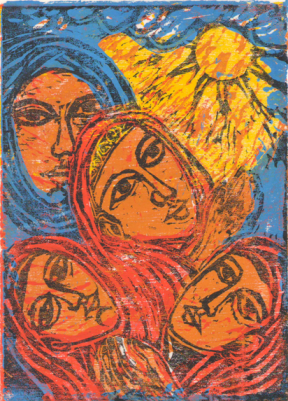
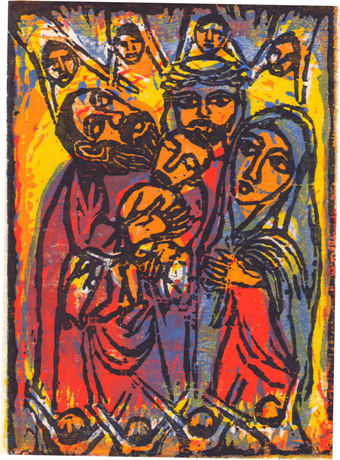
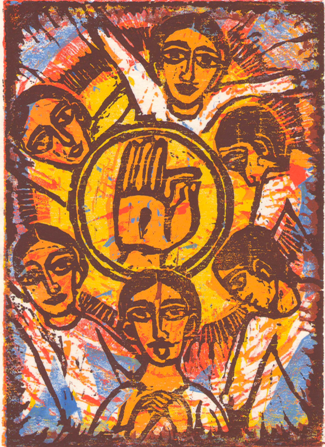
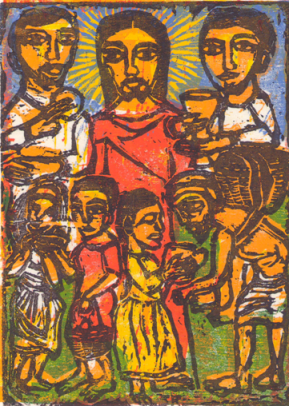

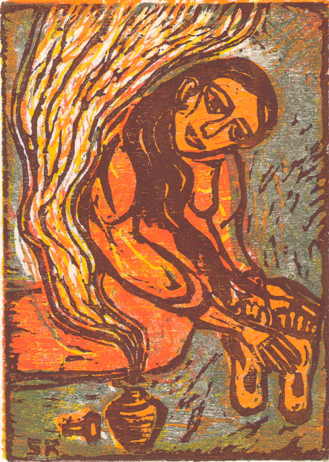
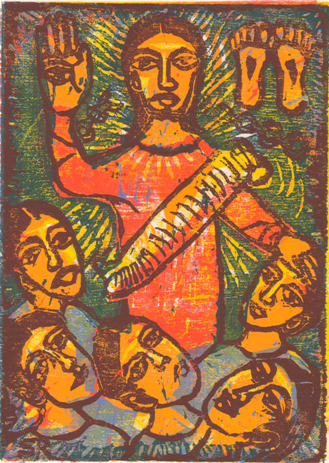
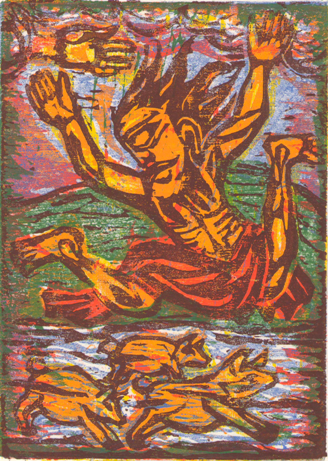
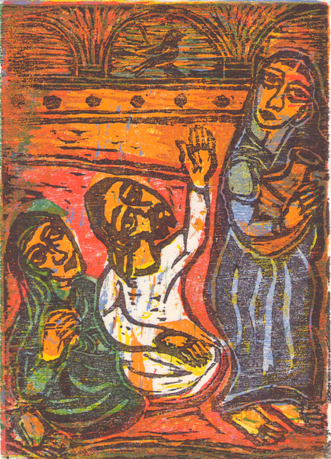
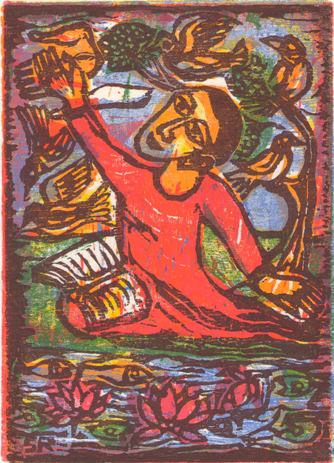
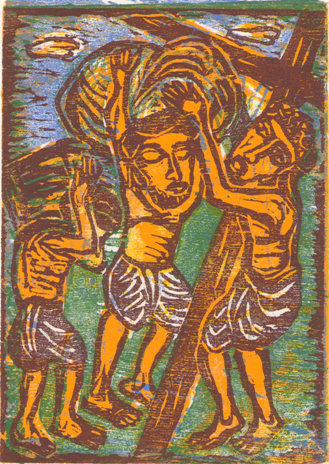
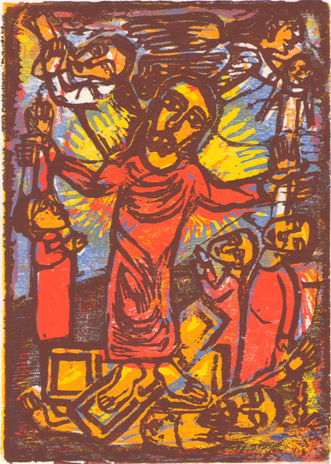
Raj, P. Solomon - by B.S. Moses Kumar
Liberation in Luke’s Gospel: An Artistic Appreciation and a Theological Analysis
by B. S. Moses Kumar, Ph.D.
Introduction
Liberation in Luke’s Gospel is one of the books of Pulidindi Solomon
Raj with his art and poetry. It may be considered the magnum opus of
Solomon Raj, on par with his seminal work, ‘A Christian Folk Religion in India:
A Study of the Small Church Movement in Andhra Pradesh’. Though it is not
voluminous (actually it contains 40 pages), it has been widely known globally,
being published in German (1991), Dutch, English (1996), and Telugu (2010)
languages. As the subtitle in the English edition shows, this book is a
conspicuous combination of ‘Image and Word’ emerging from the paintbrush
and the pen of Solomon Raj. The artist has done these color woodblock
prints during 1987-88, as part of his research study at Selly Oak Colleges,
England, where he was a professor of cross-cultural communications.1 The
purpose for which this publication was made, in author’s words, was “for
meditation, Bible study and prayer in groups”.
The present paper has a three-fold purpose: It traces a brief historical
development of these works, presents an artistic appreciation, and brings out
a theological analysis of the themes embedded in these works. For the sake
of readers who are new to the art of Solomon Raj, and to refresh the memory
of those who knew this series, reproductions of the twelve wood block prints,
dealing with the theme of this essay, are given in the body of the text.
Historical Development
In the author’s Introduction to the book in English, we find how Solomon
Raj was impressed by the ‘liberation motif’ found in the most familiar texts of
Luke’s narrative, and how he was inspired to produce all these 12 wood block
pictures on a single theme, namely, the hand of God at liberation. He
chronicles the origins of this work in a simple, yet significant manner:
I was reading the gospel according to St. Luke in the Bible
searching for passages related to freedom, liberation or what may
be called redemption. Humanity, nay the whole creation needs
liberation, a liberation from many kinds of bondage. So I made
these pictures to bring out the idea of liberation or freedom. With
each picture I have written short meditations … the outcome of my
quick reflection on each text.2
According to Fr. Ubelmesser S.J., the Mission Office in Nuremberg
dedicated Christmas issues of their magazine each year to a special subject
on inculturation, presenting the work of a particular artist each time. Their
magazine for Christmas 1984 contained eight works of Solomon Raj. “They
are embedded in photos of dalits and tribals, as well as in texts of dalit
literature; and this at a time, when the struggle for dalit liberation was still fresh
and new, even in India.”3 When Dalit Liberation Theology was taking shape in
Bangalore, South India with the reflective views of A. P. Nirmal, and was
emerging as a movement to reckon with in early 1980’s, Solomon has taken
this message, almost simultaneously, beyond the boarders of India through his
art and reflective verse. In 1988, the Nuremberg Mission Office published The
Living Flame and the Springing Fountain by Solomon Raj with 30 pictures of
his batiks, which is out of sale (just a few copies left in the archives). The
Indian Society for Promoting Christian Knowledge (ISPCK), Delhi published
the English text edition of this book in India. The Christmas issue of
Nuremberg Mission’s magazine in 1991 was again entirely dedicated to the
works of Solomon Raj, this time on Liberation in Luke’s Gospel.
The art in this book has been used in Chicago in recent years and this
accounts for its continued impact on the successive generations. The
Lutheran Church of St. Luke of Itasca, Illinois has thoughtfully used these
twelve woodcuts as basis for their ‘Meditations for the 12 Days of Christmas’,
commemorating their centennial. Solomon was very appreciative of this work
and the commentary involved in the project:
This is the kind of response I always welcome. My artwork is not
prescriptive or restrictive in any sense, but it aims at being
evocative. That means that the viewers are welcome to bring their
own experience and perception into play when they see the works
and express their own ideas.4
Artistic Appreciation
In his Foreword to this book, Bishop Sam Amirtham extols the
liberation motif in the Bible, which was artistically portrayed by Solomon Raj
as follows:
Our God is a God of liberation. We know this from the history of the
Hebrew tribes who, by God’s hand of deliverance, successfully
escaped from the bondage in Egypt. This Exodus paradigm is
repeated over and over again throughout the books of the Bible,
even unto our present times. God’s liberation has been
experienced again and again by different peoples throughout
history. It is a historic reality …
The birth, the life and the ministry of Jesus Christ constitute the
supreme act of God’s liberation for the whole world. St. Luke, the
physician, researcher and evangelist, put in a lot of historical
research in painting his Gospel narrative of the liberation stories of
our Lord. The physician chose a particular and unique perspective
to present the Gospel as he saw it: the liberation in Christ Jesus.5
Amirtham further appreciates Solomon Raj and his contribution in this
significant book:
Dr. Solomon Raj, resting in St. Luke’s tradition, uses pictures,
poetry and prose to articulate this liberating messages [sic] of Jesus
Christ in this gospel according to Solomon Raj. It is an original
contribution of the Indian church to the whole Oikoumene.6
Having a close association with the artist, Fr. Ubelmesser extols the
work of Solomon Raj and the ethos of such religious art, from a firsthand
experience:
His paintings, batiks, woodcuts and his verses are in all their Indian
garb a beautiful expression of our common faith in Jesus Christ and
his gospel. After all he has spent most of his life just doing this:
integrating our faith with brush and word.7
The wood block printing technique had its superb expression in the hands of
Solomon Raj in the cut and the color of each work. In fact, each work is a
masterpiece by itself with beautiful imagery and rich indigenous symbolism. In
the Telugu text edition of this work, Solomon presents a brief description of the
Signs and Symbols used in these works. They are familiar to the Church
across the past 2000 years as they emerged from the imagination and
portrayal by artists. K. Sam Mathew made an interesting study of Solomon’s
symbolism when he submitted his dissertation for Master of Theology to the
Senate of Serampore College,8 though this study was limited to indigenous
symbols in selected Batiks of Solomon. The signs and symbols are like ‘mini
parables’ with a voice of their own and a meaning.9 A mention is made of the
symbolism in each of these works with their particular meaning and message
as we move through the following analyses.
A Theological Analysis
The titles of the works in the book, and the distinct types of liberation
they envisage may be listed as follows:
1. The Handmaid of God - Liberation from Social Prejudices
2. Darkness and Sin - Liberation from Darkness
3. Oppressors and the Oppressed - Liberation from Oppression
4. The Lord Remembers the Hunger - Liberation from Hunger
5. We and They - Liberation from Barriers
6. More Love and More Forgiveness - Liberation from Guilt
7. The Fourfold Bondage - Liberation from Bondages
8. Demons and Devils - Liberation from Demonic Powers
9. Needle in the Haystack - Liberation from Too Many Cares
10. Body and Soul - Liberation from Bodily Concerns
11. Burdens of this World - Liberation from Burdens
12. Gentle Brother Death - Liberation from Fear of Death
An analysis of these 12 works is in order at this juncture. This analysis will be
two-fold: a general treatment with artistic significance and a theological
analysis with their specific message. Since the primary focus of all these
works is liberation, the order of the sub-titles is used in the following analysis,
instead of the ‘imaginative titles’ given by the artist to each of these works.
1) Liberation from Social Prejudices
The first work, entitled ‘The Handmaid of God’ is based on Luke
1:48, which reads, “For he has looked on the humble estate of his servant.
For behold, from now on all generations will call me blessed”. This is from the
Magnificat, ‘blessed’ Mary’s Song of Praise, which extols the theme of the
bonded becoming the blessed, and this reminds us of ‘gender liberation’.

The prejudice for women in the Jewish society needs no mention for
anyone who knows the Jewish Prayer: “Blessed art Thou, O Lord our G_D,
King of the universe, Who hast not made me a woman”. And also the prayer
to be said by a Jewish man every day: “Thank God for not making me a
Gentile, a woman or a slave” (from Jewish Talmud). And the prejudice for a
place is also obvious in the way the town of Nazareth, from where Mary hailed,
was belittled: “Can anything good come out of Nazareth?” (John1:46). Whether
women are spoken high, or treated low, the artist could see the divine
perspective that leaves no room for ‘social prejudice’ in the last stanza of his
meditative reflection:
For all that we know
when God decided to become incarnate
He chose to enter
the womb of a woman.
Solomon Raj emerges as a Champion of Women Liberation, deliberately
or otherwise. In the Telugu edition of this work, the author concluded each
reflection with some profound sayings – expressed in couplets and stanzas.
The saying at the end of this first work reads likes this:
He has gone and seen the depths of divine will
Who desires the progress of womankind.
(stree jaati pragatini aasinchuvaadu
daiva sankalpaambudhini digi choochinaadu).10
The symbol of star in gold color at the right upper corner, which the
author mentions, is a sign for heaven and for divine revelation. Viewing it as
sun, it is commented that as the sun “brings the light that frees all humanity
from darkness”, “Humankind, represented here by the four women, waits for
the coming of the Light of the World in a spiritual sense”.11 It is interesting to
know that Solomon has produced a similar series of 12 woodcuts, on ‘Jesus
with the Women’.12 The artist upholds the place of women through these
twelve portraits of women. The book with these woodcut prints by Solomon,
with matching devotions by Jorg Dantscher, S.J. was published in German a
decade ago.
2) Liberation from Darkness
The second work entitled ‘Darkness and Sin’ is based on Luke 2:30-32
containing Simeon’s song: “For my eyes have seen your salvation that you
have prepared in the presence of all peoples, a light for revelation to the
Gentiles, and for glory to your people Israel.”

Jesus is portrayed here as ‘a light for revelation’ granting ‘liberation from darkness’.
The author reminds us of how the Indian sages had prayed from times immemorial:
‘Tamas’oma Jyothirgamaya’ (the meaning of this Sanskrit sloka being – ‘Lead me
from Darkness into Light’), and he hastens to declare:
Light is knowledge
Light is wisdom
Light is a sign of immeasurable holiness.
When God made the dance of creation
Light was born first.
The adjective that qualifies ‘holiness’ is very profound: ‘immeasurable’ since it
is infinite; ‘holiness’ is not something relative but is an absolute, as it is one of
the essential and eternal characteristics of God; the holiness of God, which is
infinite and immutable!
The author was aware of the beliefs of other faiths and makes an allusion to
the image of ‘dance of creation’ as he talks about creation by God. According
to Hindu mythology, Shiva ‘tandava’ is “a vigorous dance that is the source of
the cycle of creation, preservation and dissolution”.13 Though the author may
not adhere to this belief, he adapts this imagery when he talks about the
creation of light by God at the very outset, as in the Biblical narrative. And a
genuine prayer is penned in the closing stanza for personal enlightenment as
well as for universal awakening:
So give me the gift of Light
let darkness be cast behind
and let the universe be awakened
into that glorious morning
which shall not be darkened
by another night.
Light is acknowledged as a ‘gift’ from God, and as such it cannot be
attained but only be received. And the recipient of this ‘gift of Light’
experiences liberation from darkness, as darkness is ‘cast behind’ by a power
higher than one self, even God Himself coming to the rescue of helpless
mankind. Peoples are shown in the picture to be drawn from all over to the
light for revelation. Gerald A. Danzer reflects and comments about the figures
in the picture as follows:
The golden light emanating from the four figures in the background,
angels or perhaps the four gospel writers, shatters the darkness.
Four corresponding figures at the base, perhaps representing the
church today, seem to join Simeon in singing the Nunc Dimittis. As
Martin Luther paraphrased Simeon’s message: ‘Christ is the hope
and saving light of those in blindness. He guides and comforts
those in night by his kindness’.14
A slight reference may be seen here to the fatal fall of man when Satan
tempted, and consequently the universe, as well as the heart of man, was
darkened. The concluding reflection in the Telugu edition conveys the
following meaning:
The mind of the wicked that loves darkness
cannot see there is such thing as Light;
Those who desire the state of darkness
cannot smell the Heavenly Light.15
The author anticipates with prophetic hope, ‘that glorious morning which shall
not be darkened by another night.’
3) Liberation from Oppression
The third work, ‘Oppressors and the Oppressed’ is based on Luke 1:52-
53, which reads: “He has brought down the mighty from their thrones and
exalted those of humble estate; he has filled the hungry with good things, and
the rich he has sent away empty.” This again is taken from the Magnificat.
The curse of sin upon mankind necessitated the Incarnation! Here is a
beautiful imagery of a tree – ‘the tree of sin’ bearing the fruits of ‘classes and
castes’, and ‘unjust structures’ heaping oppression and injustice upon
mankind.

The outcome of the ‘unjust structures made by man’ is graphically described:
Some get rich at the cost of the poor
some get fat
from the perspiration of the week.
Classes and castes not only perpetuate the existence of the oppressed and
the oppressors, but they serve their contradicting destinies as ‘rungs for the
high’ and ‘crushing berths for the poor’. There is rich symbolism in this work.
The wheel in the center is a sign of divine fullness and perfection. The Lord’s
wounded hand is within the circle. Here we see the thumb and the pointing
finger joined, which symbolize the unity of Christ’s divine and human
natures. Danzer with intent reflection makes a lucid comment:
The hand of Jesus, bearing the scar of the crucifixion, is raised in
blessing. The artist explains: ‘The thumb and the first finger is the
Byzantine symbol of Christ blessing and teaching. This is a well-known
symbol from Eastern Orthodox iconography connecting the
two natures of Christ, the human and the divine … I have
used this symbol many times to indicate the two natures of Christ.’
The six followers that Solomon Raj places around the circle of
blessing have looked and have seen. They seem to come away
from the blessing in a variety of moods. One lifts up his arms in a
sign of victory, others look like they have resolved to follow a certain
course of action. And still others are singing hymns or reciting
psalms. All show individual expressions on their faces, but their
arms and hands seem to converge in fellowship. The circle of the
believers is where the hungry are filled with good things, where the
celebration is held.16
As the scriptural foundation spells above, God the Equalizer ensures
‘Justice for All’ by His two-fold intervention: bringing down the mighty from
their thrones and exalting the humble; and filling the hungry with good things
and sending away the rich empty. The author longs for the advent such a
redeemer and the redemption He grants:
The redeemer will bring
justice to the poor one day
taking his place
with those who are oppressed.
The Redeemer identifies with the oppressed, as “He was oppressed and
afflicted” (Isaiah 53:7) and ultimately takes his place with them when he took
their sorrow and suffering, and died on the cross.
4) Liberation from Hunger
The fourth work entitled ‘The Lord Remembers the Hungry’ is based on
Luke 22:19 which reads: “And he took bread, and when he had given thanks,
he broke it and gave it to them, saying, ‘This is my body, which is given for
you. Do this in remembrance of me.’”

Using this passage related to the ‘Last Supper’ Solomon Raj communicates
the truth that the Lord remembers the hungry and ensures liberation from
hunger for all such people. The Lord’s body given for others not only satisfies
the spiritual hunger of people, but also challenges and enables them to feed
the hungry. Thus the author encourages the reader to participate in this
ministry of sharing, which ensures the prospect of a great reward:
Break the bread, break the bread
share your bowl of rice
there are many hungry souls around.
Give your cup of water
to a thirsty child
and your reward will be great.
Break your bread, break your bread.
Whenever you share your bread
and part with your cup
there is always communion.
God is surely present in
that bread and the cup.
As Danzer remarks, Solomon combines two familiar incidents in the life
of Jesus in this work:
The feeding of the five thousand near the start of his ministry and
the institution of the Lord’s Supper towards its end. In between
these two events Jesus directs every disciple to work for freedom
from hunger in every sense of the word – physical, mental, and
spiritual. The lateral movement in the image suggests that working for
freedom from hunger, a mandate given to each individual disciple
also has a group dimension. Note that one follower shoulders a
large basket at the end, one of the twelve containers in Luke’s story
… These symbols of God’s superabundant grace announce a time
for thanksgiving.17
5) Liberation from Barriers
The fifth work, ‘We and They’ is based on Luke 13:29 which reads:
“And people will come from east and west, and from north and south, and
recline at table in the kingdom of God”. The Divide between the human
community resulting from man-made barriers and the predicament of such
discrimination is well brought out in the following lines:
Who is in, who is out
in these man-made boundaries?
Trenches that people cannot cross
Walls that nations cannot scale.
The scribe would not eat with
the so called sinner
the Pharisee not with the publican.
Castes do not mix
colours do not blend.
Yin will keep off from the Yong.

Danzer comments that the barrier is a dynamic line that separates the
‘red-robed saints on one side and the blue individuals on the other. He further
describes:
The reds, with hands folded, seem to be leading the procession to
the banquet hall. The blues, on the other hand, are in sad disarray.
Their eyes seem to be cast down; maybe they have been cut off
from the march by a human barricade. They need to scramble to
find a place at the end of the line. Jesus realizes their plight; he knows
the discrimination they face. His next words comfort them, ripping out
obstacles to faith and obstructions to fellowship: ‘There are those who are
last who will be first’. And then, when all have their places, a mighty
chorus erupts in praise and thanksgiving.18
The author laments about these manmade barriers, which keep humankind apart,
and he graphically portrays this Divide through the symbol of Yin Yong. On one
side are the depressed and the downhearted while on the other side we see those
who rejoice. The line that divides these two must go away and all must share the
joy of the Lord. And the artist anticipates that day when east shall meet with the
west (across the continents) and north with the south (within the nations), and
ultimately ‘saints and sinners shall share the kingdom of God’.
6) Liberation from Guilt
The sixth work, ‘More Love and More Forgiveness’ is based on Luke 7:47
which reads: “Therefore I tell you, her sins, which are many, are forgiven – for
she loved much”. In a dramatic incident at a prominent Pharisee’s house, a
sinful woman had done something that is forever memorable. The artist
reflects on the ensuing theme of forgiveness in simple but beautiful verse by
means of an immutable equation:
The more my sins
The more is my love.
The more my love
The more is the forgiveness
I receive.

The title in Telugu is loaded with strong adjectives meaning ‘Infinite Love
– Incomparable Forgiveness’ (Amitamagu Prema – Atulitamagu Mannimpu).
Mary here adores the feet of Jesus, which are portrayed through just the sign
of His wounded foot. The perfume that ascends is a symbol of prayer that
rose up from her heart. This woman of ‘ill repute’ entered the room ‘uninvited’,
and her tears of remorse and repentance knew no bounds as they wet Jesus’
feet. She endeavors to dry them with her hair and in the process kissed them
and anointed them with a precious perfume. Danzer aptly comments:
It was quite a scene and the artist has dramatically portrayed the
fragrance of the ointment rising like incense, carrying the woman’s
prayer to the heavenly throne. Simon pointed to the women’s sins,
heaping on her guilt. Jesus, however, struck by her love, forgave
her the many sins she had accumulated.19
The artist uses rich imagery as he explains the grand outcome of the
event. Just as the snow melts when the sun shines on the icy peaks, ‘the dirt
and the dust get washed away down the hill’ when the tears of repentance
flow from one’s heart. And the sinful woman became a sanctified woman,
when God’s gracious forgiveness was granted in response to her genuine act
of penitence. His joy and His peace filled her heart as the ‘perfume’s
captivating aroma’ filled the room. Gone was the guilt, which had a heavy toll
on her for long until she came to the Lord. Though she approached Jesus and
entered the room ‘uninvited’ the compassionate Lord proved that no sinner
who comes to Him will ever be cast away.
7) Liberation from Bondages
The seventh work entitled ‘The Fourfold Bondage’ is based on Luke 4:18
which reads:
“The Spirit of the Lord is upon me,
because he has anointed me
to proclaim good news to the poor.
He has sent me to proclaim liberty to the captives
and recovering of sight to the blind,
to set at liberty those who are oppressed,
to proclaim the year of the Lord’s favor.”
This picture shows Jesus reading the scroll from prophet Isaiah when he first
visited the synagogue at Nazareth. This so-called Nazareth Manifesto of
Jesus envisages the four-fold liberation, which symbolizes ‘the coming of the
kingdom of God’. The artist reflects on this as he heralds the Good News of
hope:
The poor and the hungry
the oppressed
and the downtrodden;
the casteless and the cast out
shall hear the good news
of hope.
This shall be the coming
Of the kingdom of God.

The Kingdom of God is the embodiment of the ‘goodness of hope’ - nothing
less and nothing else! The four-fold liberation here is portrayed through rich
symbolism. We see an eye on the right hand of the Lord, and this is a sign
that the blind will see! In the upper right hand corner we see the wounded
feet of Jesus, and this is a sign that the lame will walk! There is a broken
chain around the head of the Lord, and it is a sign of ‘liberty to the captives’
and the oppressed! And finally we see a scroll around the shoulder of the
Lord, and this is a sign of the ‘good news to the poor’! Danzer points out
another significant symbolism when he says, “Our Lord has one hand raised
in proclamation, the other set in blessing”. Danzer further makes a
shrewd remark about the response to Jesus’ sermon:
At first the homily was well received; soon afterwards the
congregation rose up in rebellion. But the old message of freedom,
recovery, sight, emancipation, and grace remained timely. The
shawl reminds us of the scroll from which Jesus read. His feet, nail
scars and all, suggest the way of the cross.20
8) Liberation from Demonic Powers
The eighth work ‘Demons and Devils’ is based on Luke 8:33 which reads
as follows: “Then the demons came out of the man and entered the pigs, and
the herd rushed down the steep bank into the lake and were drowned”. In this
dramatic scene, Jesus ‘ordered a whole band of evil spirits to come out of an
unfortunate man’ and delivered that demon-possessed man. Presenting the
theme of ‘liberation from demonic powers from the story of the ‘Legion’,
Solomon laments - ‘people in many lands still live in the fear of demons’ and
therefore he longs for liberation for all:
We all need to be freed
from demonic powers
from demons that bother us today –
demons, may be,
of a different kind.

In the Telugu version of this book, the different kinds of demons we find
prevalent are hinted: the demon of drunkenness, the demon of discord
and strife, the demon of lust for money, and the demon of corruption.
We can still think about other demons such as racism, terrorism, gender
discrimination, molest, domestic violence and so on, which plague our
society today. Danzer points out how Solomon pictures the scene in three
parts:
First there is the authoritative hand of the Christ at the upper left.
The unfortunate man’s body, jolted by the exit of the demon host,
dominates the picture, almost propelling the character off the page.
Meanwhile the herd of pigs, ill-fated, plunges into the waters at the
bottom of the panel. Our liberation from our own demons came at a
great price, the suffering and death of our Lord.21
9) Liberation from Too Many Cares
The ninth work with the title ‘Needle in the Haystack’ is based on Luke
10:41-42, which reads as follows: “But the Lord answered her, ‘Martha,
Martha, you are anxious and troubled about many things, but one thing
is necessary. Mary has chosen the good portion, which will not be taken
away from her.” Though the title is not a biblical phrase, it very well
describes ‘the many cares that seem to pile up in our lives, reaching
haystack proportions’. The search for the only one thing needed, as
Jesus tells, suggests ‘looking for a needle in our haystack’. The artist
remarks that in the good olden days, things like family, children and
wealth to enjoy were considered ideals. But as things change, he
points out, the world became more complex.
As a result,
Goals and values shift
desires and ambitions keep expanding
and in the haystack of too many cares
humanity lost the needle
of life’s compass.

Danzer comments as follows, extolling the blessed house, ‘where Jesus Christ
is all in all’:
Look as hard as we might, neither the needle nor the haystack is
evident in this print. Instead, with the hint of the text, we see the
story of Mary and Martha. Luke tells us that Martha (on the right)
invited Jesus into her home and was busy preparing the meal.
Mary meanwhile was listening to the words of our Lord. In a fit,
Martha demanded that Jesus send Mary to help her, but the Lord
pointed to the one thing needful, the one that Martha had misplaced
in her haystack of worries.22
Mary with folded hands is a sign of devotion and Martha tightly clutching her
jar is a sign of anxiety and worry. The bird above on the branch is a reminder
of God’s Word.
10) Liberation from Bodily Concerns
The tenth work entitled ‘Body and Soul’ is based on Luke 12:22-23 which
reads as follows: “Therefore I tell you, do not be anxious about your life, what
you will eat, nor about your body, what you will put on. For life is more than
food, and the body more than clothing.” The carefree ‘flowers of the field’ and
the ‘birds of the air’ Jesus uses as a means of his didactic exercise, and
through these He nails down the challenge of trusting God for all needs.

These three objects are beautifully pictured in this work – the birds above and
the flowers below (which are Indianized and pictured as lotuses). The man
who delights in the Law of the Lord is shown worry-free putting his hand in the
hand of God. Danzer points out that this print, which focuses on bodily
concerns, food and clothing, goes much further in
making its point:
God cares for you, just as he attends to the
needs of birds and fish, flowers and trees.
The birds above and the fish below animate
this scene as everyman lifts up a hand
toward the heavens in praise to the
Almighty. An indistinct image (as in this
version of the prints) seems to uphold the
uplifted hand. It looks like a powerful hand
sustaining and blessing all of creation.23
Danzer further remarks that “The artist’s audience in India would
immediately respond to the lotus blossoms, symbols of spiritual
life and objects encouraging meditation. Freedom from worry about
bodily cares emancipates the mind to tend to the soul.”24
11) Liberation from Burdens
The eleventh work, ‘Burdens of this World’ is based on Luke 11:46 – “And he
said, ‘Woe to you lawyers also! For you load people with burdens hard to
bear, and you yourselves do not touch the burdens with one of your fingers’.”
Solomon uses this text to depict the loads and burdens humans carry almost
every day of their existence. He beautifully portrays the ‘Suffering Servant’
alongside humans, Who carried all the load of Sin upon Himself on the cross.
With much enlightenment on the philosophy of life, he conveys a fact in simple
terms:
There are some things
which we know
and others
which we do not know.
We know there is suffering
in this world.

Many things, this side of heaven, we may not know; but we all invariably
know ‘there is suffering in this world’. We often do not know the ‘why’ of it, in
our own lives, and also in the lives of others. This ‘mysterious’ element of
suffering is like a puzzle and every puzzle has its answer; it is only a matter of
when we find it. With inner assurance the artist encourages: “We wait for
God’s liberation from suffering, we wait for God’s answer”. The common
tendency of the fallen human race is to shift loads instead of sharing burden.
As a result some carry more of the burden and heavier loads than others.
Danzer points this out as he comments:
The warning about not to load people with burdens they can hardly
carry is on of six woes listed by Luke when summarizing one of our
Lord’s table talks. A positive command is implied in his follow-up
observation about helping those who are struggling. The Apostle
Paul later summarized Jesus’ message: ‘Carry one another’s
burdens’.25
From his perception of the portrait, Danzer makes further enlightening
comments:
The artist shows one person passing his load on to another, a
person already burdened with his own baggage. And then there is
a smaller fellow, maybe a youngster, crushed down by the weight of
the freight he is carrying. But the compelling image in the picture is
the cross, slashing across the scene, putting everything in
perspective. Jesus carried our burdens, even to death on the
cross. Our proper response to God’s mercy is to help free others
from their burdens.26
12) Liberation from Fear of Death
The last work, ‘Gentle Brother Death’ is based on Luke 24:1-2 which
depicts the resurrection of Jesus Christ. The ‘imaginative title’ the Solomon
gives to this portrait is ‘Gentle Brother Death’. This is obviously the description
he borrowed from St. Francis of Assisi, who called Death as ‘Gentle Brother’.
The artist in the accompanying verse addresses the many philosophical
questions and perplexities about what happens after death:
At the time of death
where does the soul make its journey?
To the land of the fathers,
or the land of Gods?
Into the night or into the day?
Into the cloud or into the lightening?
Into the full moon or the new moon?
Into the dark fortnight
or the bright fortnight?

In the midst of these questions and perplexities, Solomon comes up with a
certainty that has its scriptural foundations in abundance:
But we surely believe
that death is the doorway
to a new life
more glorious and more wonderful.
As Danzer comments, this last image in the series “pictures Christ the
Liberator lifting people out of their coffins and giving them new life”. When
Christ had conquered Death, the doors of death were broken, and Death was
bound captive with chains at the feet of Christ. (The chains are clearly shown
in the original version of the late 1980’s.) We see couple of angels above –
one blowing a trumpet, which is a sign of resurrection; and the other carrying
a child, which is a sign for the angels taking spirits to heaven. Danzer rightly
sums up the message:
The Christ figure assumes the shape of
a dynamic cross, energy bursting forth
from the center. Jesus elevates a
young person with his right hand and
another – it looks like a woman – with
his left, giving them new life. In
response, the skies are filled with
jubilation and the redeemed seem
ready to burst into a song: ‘Our souls
are waking. Our bonds are breaking …
Now and forever. Alleluia’.27
Conclusion
Using the technique of wood block printing, and mining a great theme from
twelve different quarries in the Luke’s Gospel, Solomon has presented the
world a great message of all times – the message of Liberation! This is the
need of all times, this side of heaven, and for all diverse people groups of the
universe. In depicting the Liberation the Lord gives, Solomon combined his
twin instruments of the paintbrush and the pen, and brought out the message
in simple but sharp terms. This series of twelve pictures in large original
prints are on permanent display in many places in Germany, Netherlands,
Switzerland, England and the U.S.A. Wood block printing is an ancient art
form in Japan, but was popular in Germany also from the time before the
invention of the printing press. And as an art form it is now well known and
widely practiced all over the world. Solomon explained a brief procedure of
this art form in this book.
The artist, apart from enjoying his art with his own reflections, longed
that “those who look at these pictures will bring out their own reflections in
response to these pictures”.28 His longing has been fulfilled from time to time,
as many people in places reflected on different works of this Series. It is a
happy surprise when it was fulfilled in plenitude as The Lutheran Church of St.
Luke, Itasca, Illinois celebrated their centennial with Gerald Danzer’s
‘Meditations for the Twelve Days of Christmas’ through these liberations prints
of Solomon Raj, published in 2008. Solomon’s message of liberation will ever
remain with us! This study is hoped to refresh many who have seen his art
and verse, and for the new generations, who are new to this great
contribution, that it would help communicate the richness and beauty of his
message, and challenge them to herald this message for those who need
liberation in our times.
Dr. David Zersen, President Emeritus of Concordia University, Austin,
Texas, who was the former Pastor of The Lutheran Church of St. Luke, Itasca
did a commendable job in the celebration of this art and this message, most
appropriately merging it with the centennial celebration of The Lutheran
Church of St. Luke, Itasca. It is fitting to note his reflections, as we conclude:
The Gospel must be shared in a way that it comes to find a home in
your mind and heart, and in the culture of your society. It is the task
of the preacher or the poet or the singer or the painter to find the
way to allow the Good News about God’s love in Christ to find a
patch of ground and to blossom in our lives. When this happens
profoundly, the dance or the song or the art that results from it
reflects the joy of the life that experiences it.29
And what an accomplishment for Solomon, as he dedicated his pen and
paintbrush just for such a task as this, and what a challenge it is for our
generation!
Dr. B. S. Moses Kumar is the Field Superintendent for India for IPHC Ministries,
and heads the Hyderabad Bible College as its President. He is a triple graduate
holding B.A., B.Ed., and B.D. He holds an M.A. in English Literature and a P.G.
Certificate in Teaching of English (PGCTE) from EFL University. He did his M.Th.
in Pastoral Theology from University of Wales, and did Ph.D. in English Literature f
rom Agra University. His Doctoral Dissertation (The Religious Poetry of Gerard
Manley Hopkins: A Theological Perspective) was published by ISPCK, Delhi.
His ‘Setting Stones: An Interpretive History of the International Pentecostal
Holiness Church in India’ was published by LSR Publications, Franklin Springs,
Georgia. He is currently doing Ph.D. in Theology with dissertation on ‘Incarnation
of the Gospel in Indian Culture with Reference to the Art and Poetry of Pulidindi
Solomon Raj’.
References:
- Now We Are Free, The Lutheran Church of St. Luke, Itasca, Illinois: 2008.
- Sam Mathew, K. : A Study of Indigenous Symbols in Selected ‘Batik Paintings’
of Pulidindi Solomon Raj as Means of Communicating the Gospel in India
(Unpublished Thesis), 2009.
- Solomon Raj, P. : Liberation in Luke’s Gospel, St. Luke’s Lalit Kala Ashram,
Vijayawada: 1996
- Solomon Raj, P. : Luka Suvarthalo Vimochana Prasakti, St. Luke’s Lalit Kala
Ashram, Vijayawada: 2008.
- Scripture Quotations, unless otherwise indicated, are from The Holy Bible:
English Standard Version, Crossway Bibles: 2007.
Notes
1. The color wood block prints in this Paper are reproduced from the Originals made
afresh by the artist in 2006 – the whole set preserved in the archives, and copies kept
as permanent exhibits at Hyderabad Bible College, Hyderabad. There is a brightness in
hue and a slight variation from the original prints of 1980’s – but with the same
unchanging message. These prints are similar to those published by The Lutheran
Church of St. Luke, Itasca, Illinois in 2008.
2.Solomon Raj, Liberation in Luke’s Gospel, Vijayawada: St. Luke’s Dalitkala [sic]
Ashram, n.d., p. 8.
3. Fr. J. Ubelmesser, S.J. “A Word about the Artist” in Liberation in Luke’s Gospel, p. 6.
4. Now We Are Free, The Lutheran Church of St. Luke, Itasca, Illinois: 2008.
5. Sam Amirtham, “Foreword” to Liberation in Luke’s Gospel, p. 5.
6. Ibid.
7.Ubelmesser, op. cit., p. 7.
8. A Study of Indigenous Symbols in Selected ‘Batik Paintings’ of Pulidindi Solomon Raj
as Means of Communicating the Gospel in India (Unpublished Thesis), 2009.
9. Luka Suvarthalo Vimochana Prasakti, Vijayawada: 2008, pp. 6-7.
10. op.cit, p. 9.
11. Now We are Free, op. cit., p.7.
12.Jesus begegnet Frauen, München: 2000.
13. Wikipedia: Tandava, http://en.wikipedia.org/wiki/Tandava p. 1.
14. Now We are Free, op. cit., p. 9.
15.Luka Suvarthalo Vimochana Prasakti, op.cit, p. 11.
16.Now We are Free, op. cit., p. 11.
17. Now We are Free, op. cit., p. 13.
18.Now We are Free, op. cit., p. 15.
19.Now We are Free, op. cit., p. 17.
20.Now We are Free, op. cit., p. 19.
21.Now We are Free, op. cit., p. 21.
22.Now We are Free, op. cit., p. 23.
23. Now We are Free, op. cit., p. 25.
24.ibid.
25. Now We are Free, op. cit., p. 27.
26.ibid.
27.Now We are Free, op. cit., p. 29.
28.Liberation in Luke’s Gospel, loc. cit.
29.Now We are Free, op. cit., p. 33.


